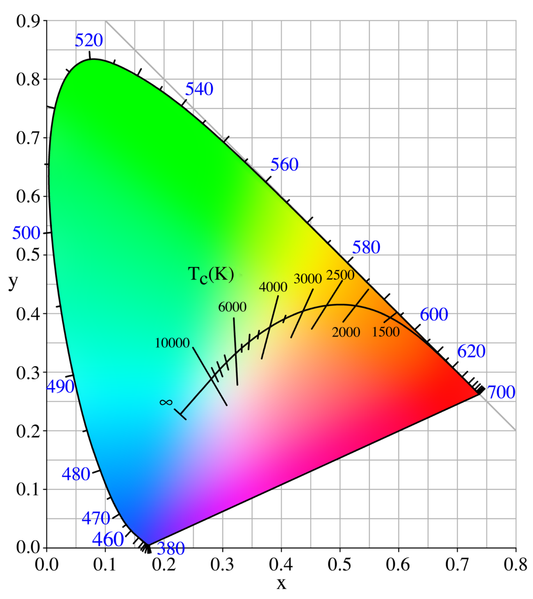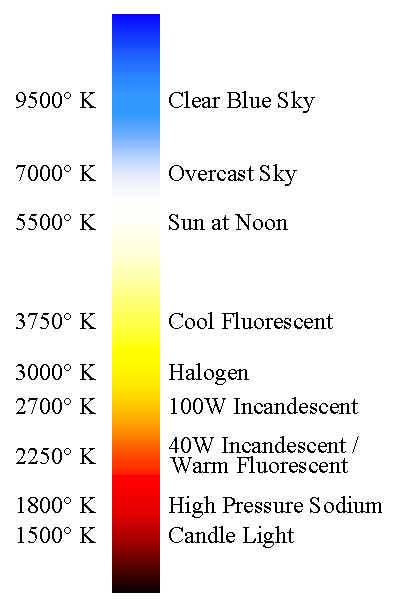
Color temperature
Color temperature is a characteristic of visible light that has important applications in lighting, photography, videography, publishing, manufacturing, astrophysics, horticulture, and other fields. The color temperature of a light source is the temperature of an ideal black-body radiator that radiates light of comparable hue to that of the light source. Color temperature is conventionally stated in the unit of absolute temperature, the kelvin, having the unit symbol K (absolute zero (0 K) is equivalent to −273.15 °C).
Color temperatures over 5,000K are called cool colors (blueish white), while lower color temperatures (2,700–3,000 K) are called warm colors (yellowish white through red)

The color temperature of the electromagnetic radiation emitted from an ideal black body is defined as its surface temperature in kelvins, or alternatively in mired (micro-reciprocal kelvins).[3] This permits the definition of a standard by which light sources are compared.
To the extent that a hot surface emits thermal radiation but is not an ideal black-body radiator, the color temperature of the light is not the actual temperature of the surface. An incandescent light bulb's light is thermal radiation and the bulb approximates an ideal black-body radiator, so its color temperature is essentially the temperature of the filament.
Many other light sources, such as fluorescent lamps, emit light primarily by processes other than thermal radiation. This means the emitted radiation does not follow the form of a black-body spectrum. These sources are assigned what is known as a correlated color temperature (CCT). CCT is the color temperature of a black body radiator which to human color perception most closely matches the light from the lamp. Because such an approximation is not required for incandescent light, the CCT for an incandescent light is simply its unadjusted temperature, derived from the comparison to a black body radiator.

The Sun
As the Sun crosses the sky, it may appear to be red, orange, yellow or white depending on its position. The changing color of the sun over the course of the day is mainly a result of scattering of light, and is not due to changes in black-body radiation. The blue color of the sky is caused by Rayleigh scattering of the sunlight from the atmosphere, which tends to scatter blue light more than red light.
Daylight has a spectrum similar to that of a black body with a correlated color temperature of 6,500 K (D65 viewing standard) or 5,500 K (daylight-balanced photographic film standard).
Lighting
For lighting building interiors, it is often important to take into account the color temperature of illumination. For example, a warmer (i.e., lower color temperature) light is often used in public areas to promote relaxation, while a cooler (higher color temperature) light is used to enhance concentration in offices
Digital photography
In digital photography, color temperature is sometimes used interchangeably with white balance, which allow a remapping of color values to simulate variations in ambient color temperature. Most digital cameras and RAW image software provide presets simulating specific ambient values (e.g., sunny, cloudy, tungsten, etc.) while others allow explicit entry of white balance values in kelvins. These settings vary color values along the blue–yellow axis, while some software includes additional controls (sometimes labeled tint) adding the magenta–green axis, and are to some extent arbitrary and subject to artistic interpretation.
Photographic film
Photographic emulsion film sometimes appears to exaggerate the color of the light, since it does not adapt to lighting color as human visual perception does. An object that appears to the eye to be white may turn out to look very blue or orange in a photograph. The color balance may need to be corrected while shooting or while printing to achieve a neutral color print.
Photographic film is made for specific light sources (most commonly daylight film and tungsten film), and used properly, will create a neutral color print. Matching the sensitivity of the film to the color temperature of the light source is one way to balance color. If tungsten film is used indoors with incandescent lamps, the yellowish-orange light of the tungsten incandescent bulbs will appear as white (3,200 K) in the photograph.
Filters on a camera lens, or color gels over the light source(s) may also be used to correct color balance. When shooting with a bluish light (high color temperature) source such as on an overcast day, in the shade, in window light or if using tungsten film with white or blue light, a yellowish-orange filter will correct this. For shooting with daylight film (calibrated to 5,600 K) under warmer (low color temperature) light sources such as sunsets, candlelight or tungsten lighting, a bluish (e.g., #80A) filter may be used.
If there is more than one light source with varied color temperatures, one way to balance the color is to use daylight film and place color-correcting gel filters over each light source.
Photographers sometimes use color temperature meters. Color temperature meters are usually designed to read only two regions along the visible spectrum (red and blue); more expensive ones read three regions (red, green, and blue). However, they are ineffective with sources such as fluorescent or discharge lamps, whose light varies in color and may be harder to correct for. Because it is often greenish, a magenta filter may correct it. More sophisticated colorimetry tools can be used where such meters are lacking.
Mired
Contracted from the term micro reciprocal degree, the mired is a unit of measurement used to express color temperature. It is given by the formula:
M=1000000/T[K]
where M is the mired value desired, and T is the color temperature in kelvins.
For convenience, decamireds are sometimes used, each decamired containing 10 mireds. The SI unit is the reciprocal megakelvin (MK−1), shortened to mirek, but this term has not gained traction.[1]
Its use dates back to Irwin G. Priest's observation in 1932 that the just noticeable difference between two illuminants is based on the difference of their reciprocal temperatures, rather than the difference in the temperatures themselves
A blue sky, which has a color temperature T of about 25,000 K, has a mired value of M=40 mireds, while a standard electronic photography flash, having a color temperature T of 5000 K, has a mired value of M=200 mireds.
In photography, mireds are used to indicate the color temperature shift provided by a filter or gel for a given film and light source. For instance, to use a tungsten light (3200 K) in natural light (say, 5700 K) without introducing a color cast, one would need a corrective filter or gel providing a mired shift of
This corresponds to a CTB (color temperature blue) filter
Blue filters |
|
|
|
|
Amber filters |
|
|
|
Filter |
Exposureincrease |
Conversion |
Mired |
|
Filter |
Exposureincrease |
Conversion |
Mired |
80A |
2 |
3200K to 5500K |
-131 |
|
81 |
1/3 |
3300K to 3200K |
+9 |
80B |
1 1/3 |
3400K to 5500K |
-112 |
|
81A |
1/3 |
3400K to 3200K |
+18 |
80C |
1 |
3800K to 5500K |
-81 |
|
81B |
1/3 |
3500K to 3200K |
+27 |
80D |
2/3 |
4200K to 5500K |
-56 |
|
81C |
1/3 |
3600K to 3200K |
+35 |
82C |
2/3 |
2800K to 3200K |
-45 |
|
81D |
1/3 |
3700K to 3200K |
+42 |
82B |
2/3 |
2900K to 3200K |
-32 |
|
81EF |
1/3 |
3850K to 3200K |
+53 |
82A |
1/3 |
3000K to 3200K |
-21 |
|
85C |
2/3 |
5500K to 3800K |
+81 |
82 |
1/3 |
3100K to 3200K |
-10 |
|
85 |
2/3 |
5500K to 3400K |
+112 |
|
|
|
|
|
85B |
2/3 |
5500K to 3200K |
+131 |